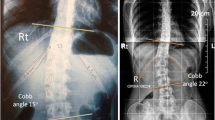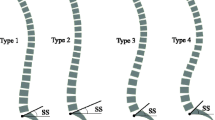Abstract.
Patients with paralytic scoliosis spend most of their time in the sitting position. The spinal deformity, pelvic obliquity and uneven weight distribution on the seating surface necessitates frequent seating adaptations in the wheelchair. In this prospective study, 45 wheelchair-bound patients were evaluated preoperatively and 43 postoperatively. The pre- and postoperative evaluation was done by an independent observer. Surgical correction was performed between 1993 and 1996. Assessments included sitting balance on a box; number of seating supports in the wheelchair; weight distribution on the seating surface, measured with a computerized EMED system; Cobb angle; hip dislocation; mediolateral translation of T1 and of the apex vertebra with reference to a perpendicular line drawn upwards from the spinal process of S1; and pelvic obliquity from a line drawn between the most proximal points in the iliac crests. X-rays for the measurement of Cobb angle and pelvic obliquity were performed in sitting position. Reference values for normal weight distribution on the seating surface were obtained for 27 normal subjects and revealed a mean value of 59% of weight supported on one side. A stepwise regression analysis on the preoperative results showed that pelvic obliquity and thoracolumbar/lumbar spinal imbalance explained weight distribution on the seating surface (R 2=0.45). There were significant improvements in all variables except in sitting balance and imbalance of T1, 1 year postoperatively. When dividing the material into two subgroups, the results showed no significant difference in any of the assessed parameters of the scoliosis, pelvic obliquity, or sitting position between individuals with even (50–59% on one side) and those with uneven (60–100% on one side) weight distribution postoperatively. The results of the assessment showed a significant improvement after surgical correction, but the majority still had pelvic obliquity and uneven weight distribution in a sitting position. The weight distribution on the seating surface preoperatively was explained by thoracolumbar/lumbar spinal imbalance and pelvic obliquity, with R 2 = 0.45. There were no significant differences in any variables in comparisons between individuals with even weight distribution and those with uneven weight distribution. For the group with even weight distribution, however, the mean pelvic obliquity was 6° and in the group with uneven weight distribution the mean pelvic obliquity was 12°. Attention to seating surface and adjustment of seating position is needed for patients with paralytic scoliosis.
Similar content being viewed by others
Author information
Authors and Affiliations
Additional information
Electronic Publication
Rights and permissions
About this article
Cite this article
Larsson, EL., Aaro, S., Normelli, H. et al. Weight distribution in the sitting position in patients with paralytic scoliosis: pre- and postoperative evaluation. Eur Spine J 11, 94–99 (2002). https://doi.org/10.1007/s00586-001-0373-7
Received:
Revised:
Accepted:
Published:
Issue Date:
DOI: https://doi.org/10.1007/s00586-001-0373-7




